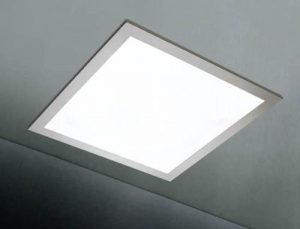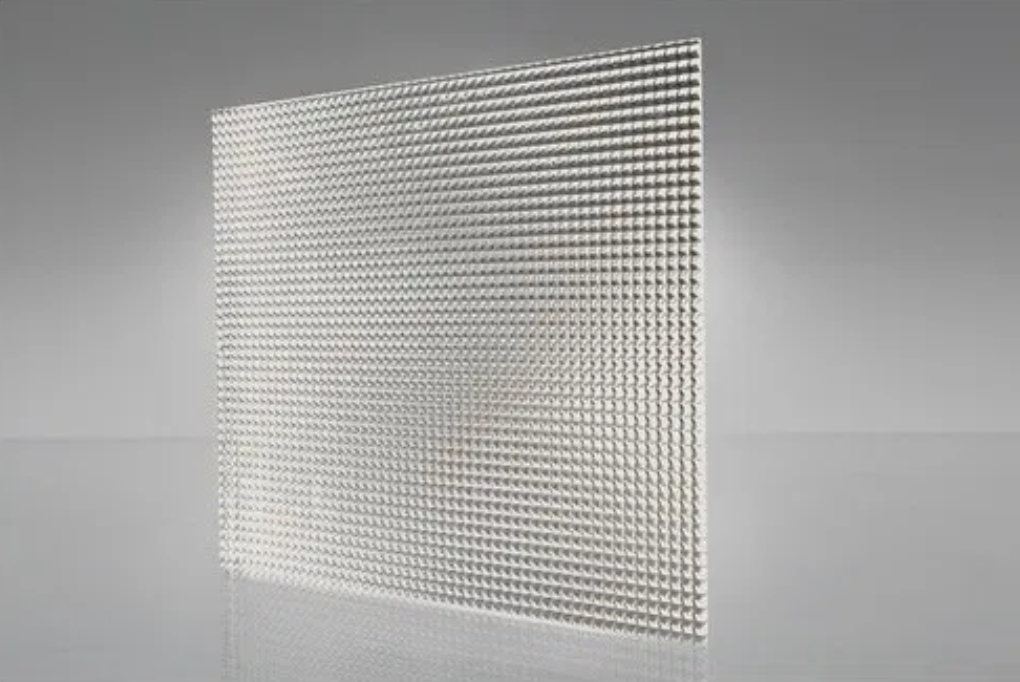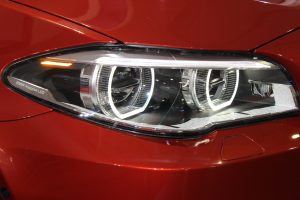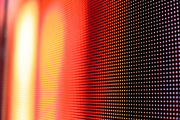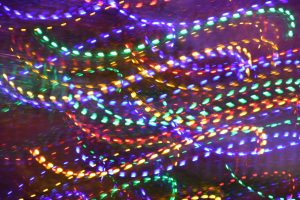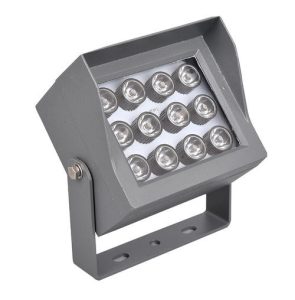What is LED light guide plate
The light guide plate uses optical grade acrylic/PC sheet, and then uses high-tech materials with extremely high refractive index and non-light-absorbing, laser engraving, V-shaped cross grid engraving, and UV screen printing technology on the bottom surface of optical grade acrylic sheet Print the light guide point.
The optical grade acrylic sheet is used to absorb the light emitted from the lamp and stays on the surface of the optical grade acrylic sheet. When the light hits each light guide point, the reflected light will spread to all angles, and then destroy the reflection condition and shoot out from the front of the light guide plate.
The light guide plate can emit light evenly through a variety of dense and different light guide points. The purpose of the reflective sheet is to reflect the light exposed on the bottom surface back into the light guide plate to improve the efficiency of light use. In the case of the same area of luminous brightness, the luminous efficiency is high and the loss is low. The single-sided microstructure array light guide plate generally adopts an extrusion molding manufacturing process.
The working principle of the light guide plate
The design principle of the light guide plate is derived from the LCD screen of a laptop computer, and it is a high-tech product that transforms a line light source into a surface light source. Optical grade acrylic (PMMA)/PC as the base material, using LCD display and laptop backlight module technology, through the high light conductivity of the light guide point, the computer calculates the light guide point, so that the light of the light guide plate is refracted into The surface light source is manufactured in a uniform light state. The product adopts the principle of spectrum analysis combined with digital UV printing technology and is manufactured under constant temperature, humidity and dust-free environmental conditions. It has the distinctive features of ultra-thin, ultra-bright, uniform light guide, energy saving, environmental protection, no dark area, durability, not easy to yellow, simple and quick installation and maintenance.
The reflection points of the light sources close to the two sides of the light guide plate are small and round and spaced apart, while the reflection points at the middle part of the light guide plate are close and roughly called ellipse. When light enters the light guide plate from the two sides of the light source and hits the reflection point, it is diffusely reflected to the surface of the light guide plate, and the other part of the light directly penetrates the light guide plate to reach the surface. The closer the light guide plate is to the light source, the stronger the direct light, and the weaker the farther it is. On the other hand, the reflection points close to the light source are small and distant, and less diffusely reflected light. On the contrary, the thick and tight points of the distant light source reflect more light. After these lights are complexly merged, the effect of the entire light guide plate is achieved.
Classification of LED light guide plates
By shape
Flat plate: The light guide plate is rectangular when viewed from the point of light incident.
Wedge-shaped plate: also known as an inclined plate, viewed from the point of light incident, one side is thick and the other side is thin into a wedge (triangular) shape.
By outlet
Printing: After the light guide plate finishes the shape processing, the dots are printed on the reflective surface by printing, which is divided into IR and UV.
Non-printing type: the dots are directly formed on the reflective surface when the light guide plate is formed. It is divided into chemical etching, precision mechanical characterization (V-cut), photolithography (Stamper), and internal diffusion.
Follow the light
Side light type: Place the luminous body (tube or LED) on the side of the light guide plate.
Direct type: Place the luminous body (tube or LED) under the light guide plate.
Press forming
Injection molding: Use an injection molding machine to inject optical grade PMMA particles into a mold at high temperature and high pressure to cool and shape.
Cutting and forming: the optical grade PMMA original board is cut to complete the finished product.
Features of light guide plate
Can be arbitrarily cut into the required size, can also be spliced and used, the process is simple, the production is convenient,
High light conversion rate (more than 30% higher than traditional boards), uniform light, long life, normal use indoors for more than 8 years, safe and environmentally friendly, durable and reliable, suitable for both indoors and outdoors.
In the case of the same area of luminous brightness, the luminous efficiency is high, and the power consumption is low.
Can be made into special shapes, such as circles, ellipses, arcs, triangles, etc.,
In the case of the same brightness, thinner products can be used, saving costs,
Any light source can be used, point-line light source for surface light source conversion, light source including LED CCFL (cold cathode lamp) and fluorescent tube, etc.
Design scheme of light guide plate
The laser dot scheme is adopted, which has the following characteristics:
- Combining different acrylic materials and different ways of use, you can use a uniform and unified laser dot layout, or you can make different sizes of dot layouts according to different specifications and ways of use. Achieve the perfect unity of commonality and specificity.
- The light guide is more uniform, and the uniformity can reach 90% or more.
- Effective use of the dense reflections of the surrounding small dots and the “twisting” function of the large dots in the middle, completely free of dark lines and “black holes”. And can make special effects.
Manufacturing process of light guide plate
Since the 1990s, science and technology have continued to advance, and the production method of light guide plates has been gradually improved, resulting in a different and early printing production. In contrast, we call it “non-printing.”
Injection Molding
It is to fill the melted forming material into a closed mold at high pressure, which requires the light guide plate and the microstructure to be completed simultaneously in the injection molding. At the same time, the mold must be made quite strong, so the mold price is also quite expensive, so it must Mass production in order to deduct the cost of high-priced molds. The single-sided microstructure array light guide plate generally adopts the manufacturing process of injection molding, and its bottom texture structure can be in the shape of a tiny lens, a microsphere, or a tetrahedral corner prism.
Photolithography
The photolithography technology is to coat a layer of corrosion-resistant photoresist on a flat silicon wafer, and then let strong light pass through the photolithography plate, and then selectively expose the photolithography plate according to the graphic information of the specific layer produced; Then the developed photoresist is taken off, leaving a thin film with a micro-pattern structure on the upper surface of the silicon wafer. The surface roughness of the light guide plate made by photolithography is not good, and the loss of light energy is relatively large.
Doping
A transparent particle material with scattering function is directly injected into the light guide plate during the injection molding of the light guide plate, and the concentration of the transparent particles can be adjusted reasonably to achieve effective control of the light, and finally high uniformity of the light can be achieved. Since the doping process is not easy to accurately control, the injection molding method is suitable for making small and medium-sized light guide plates. For large-sized light guide plates, the problem of uneven light emission may occur.
Laser engraving
The laser engraving production method is to use a computer to strictly control the energy of the laser head and the position of the laser head according to the program requirements, and use the vaporization method to depict a microstructure array with a certain size on the back of the light guide plate. This method can be very precise The depth of the scattering structure is controlled, but the efficiency is very low and it is not convenient for mass production.
Sandblasting
Use the sandblasting method to make a mold with a rough distribution surface, and transfer the rough distribution on the mold to the light guide plate during injection molding. The more rough surfaces, the stronger the scattering ability, and the rough distribution of the surface can be adjusted reasonably The light that reaches the light-emitting surface is evenly distributed.
Single point diamond machining
Single-point diamond processing is also called nano-processing technology, and its processing accuracy can reach nano-level surface roughness. It fixes the workpiece on a precision lathe and uses natural single crystal diamond tools for fixed-point turning. First, the light guide plate core is fixed on the rotating shaft to rotate, and then the fast piezoelectric feed of the diamond knife is used to complete the production. The concave-convex lens of the light guide plate is processed by the fast knife feed system and equipped with ultra-precision single-point diamond equipment.
Differences in characteristics of light guide plates
Engraving process characteristics
- Long service life. Engraving is a physical process, and the service life of the light guide plate is mainly related to the quality of the plexiglass substrate. Printing plates often cannot be used for a long time. For example, most of the ultra-thin printed board light boxes used in London Metro Station for less than 2 years have suffered a serious decline in light conductivity.
- The light guide is more uniform. When the width of the carved light guide plate is 1.2M, the light guide uniformity can still reach more than 80%.
- The light guide effect is better and the performance is more stable. In the case of the same thickness, the light guide effect of the engraved light guide plate is significantly better than that of the printed board. Especially for large format specifications, the light conductivity is better and the performance is more stable. When the width of the engraved light guide plate with 10MM thickness reaches 1.2M, the 30W T5 light source is used, and the surface illumination can reach more than 2000LUX.
- Adopt flexible craftsmanship. Each specification of the printed light guide plate must be made separately, and the finished product cannot be cut at will, so there are shortcomings in the application. The laser light guide plate can be made as a whole plate, cut and used at will, or it can be made into a special plate with a separate specification. For products with large production volume but many specifications, such as light-emitting signs, the advantages are obvious.
Laser dot characteristics
It has more obvious and significant advantages with the traditional engraving light guide plate (precision mechanical scribing method).
- The design of light guide point is more reasonable. Combine different acrylic materials. Different ways of use use different laser dot schemes. Either a uniform and unified laser dot layout can be used. It is also possible to make different sizes of outlet layouts according to different specifications and ways of use. Achieve the perfect unity of commonality and specificity.
- The light guide is more uniform and the uniformity is higher. Different acrylic materials and personalized dot design make the light guide even higher, and the light evenness can reach 90% or more. The whole is very uniform.
- Personalized dotted design, better effect. Effective use of dense reflections from surrounding small spots.
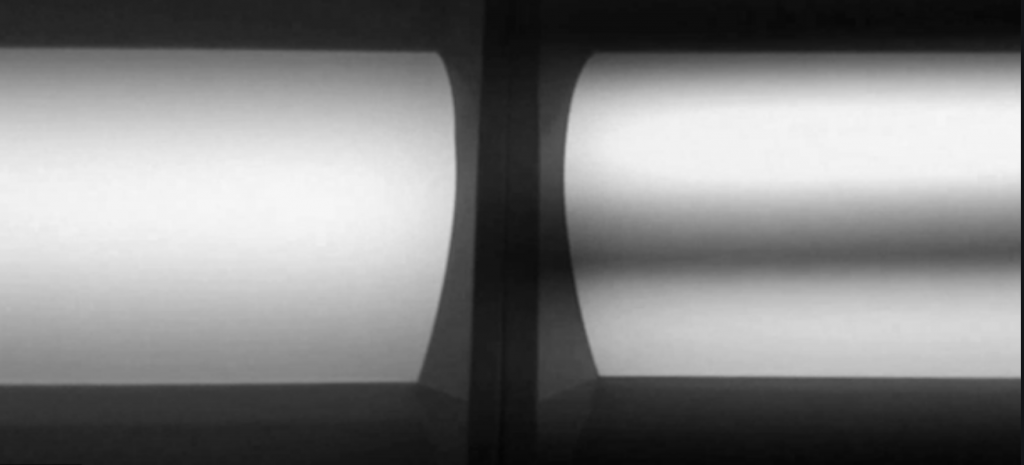
Application of light guide plate
The light guide plate ultra-thin light box is a new type of advertising carrier that is inspired by LCD TVs and draws on the backlight technology of LCD TVs (the industry calls it “ultra-thin light boxes”, but in fact it is not a light box, but is called a “luminous advertising billboard”). “It is more appropriate, and its characteristics are as follows:
- The appearance is beautiful, and its thickness is generally less than 3 cm, which maximizes the space utilization rate, beautifies the environment, and broadens the scope of application.
- The bright light is completely flat output, and it is almost perfect and uniform, completely eliminating the light and dark light marks shared by ordinary light boxes. In addition to its excellent optical characteristics, it is widely used in public places, and it has also expanded its application in high-tech fields such as precision display, photography and medical viewing, scientific research, and high-standard lighting. The effect is comparable to liquid crystal displays.
- Another commendable advantage of it is energy saving. Due to the use of advanced light guide plate lighting technology, the power consumption is only 23% of the ordinary light box with the same screen area. Based on the 1M2 screen area light box using 10 hours of electricity per day, the annual power consumption of ordinary light boxes is nearly 900 kWh, and the annual power consumption of ultra-thin light boxes is only 200 kWh, which saves 77% of electricity. Only the electricity saved in the year can recover the investment.
- The average service life of the special high-brightness and high-quality fluorescent tubes used in the ultra-thin light box is more than 8,000 hours; the average service life of the dedicated cold cathode lamps is more than 15,000 hours. The service life of the lamp tube used in the ultra-thin light box is 5 to 10 times that of the ordinary lamp tube. The extension of the service life greatly saves maintenance costs,
- The ultra-thin light box widely adopts imported high-quality aluminum alloy open-type overall frame structure, equipped with movable hooks or hanging holes, making the light box installation and screen replacement simple, fast, labor-saving, time-saving and money-saving.


